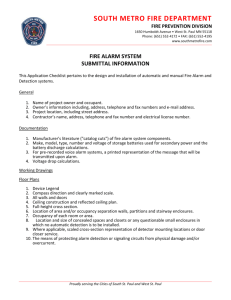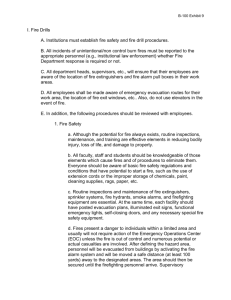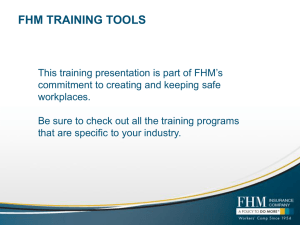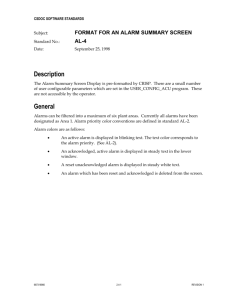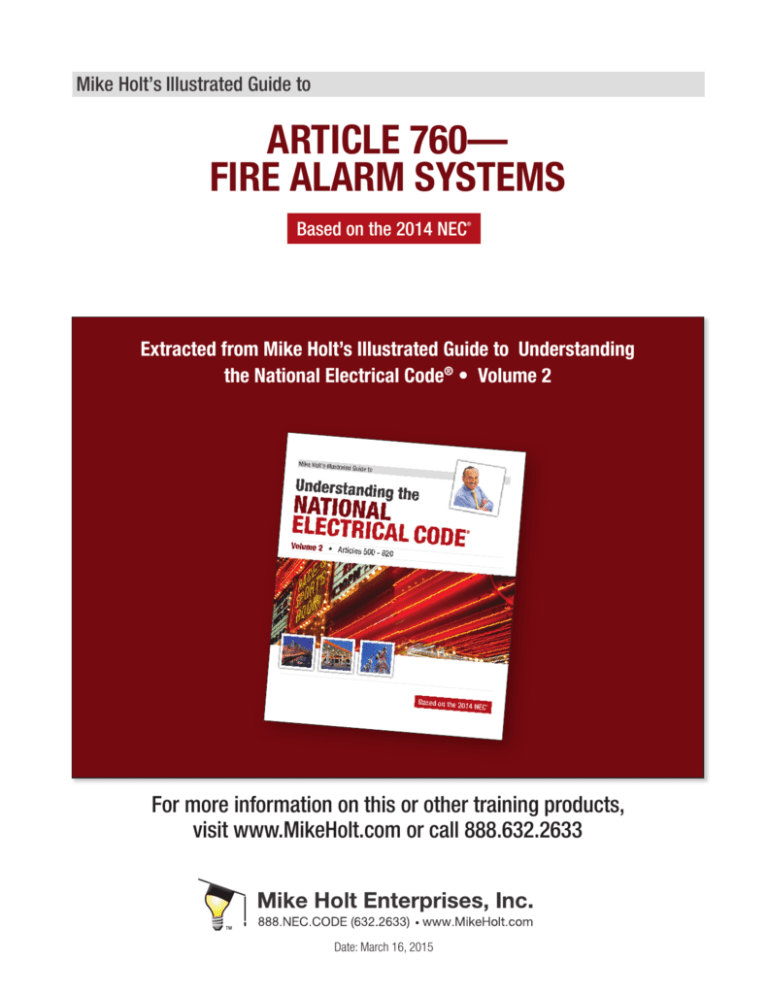
Mike Holt’s Illustrated Guide to
ARTICLE 760—
FIRE ALARM SYSTEMS
Based on the 2014 NEC
®
Extracted from Mike Holt’s Illustrated Guide to Understanding
the National Electrical Code® • Volume 2
For more information on this or other training products,
visit www.MikeHolt.com or call 888.632.2633
Date: March 16, 2015
NOTICE TO THE READER
The publisher does not warrant or guarantee any of the
products described herein or perform any independent
analysis in connection with any of the product information
contained herein. The publisher does not assume, and
expressly disclaims, any obligation to obtain and include
information other than that provided to it by the manufacturer.
The reader is expressly warned to consider and adopt all
safety precautions that might be indicated by the activities
herein and to avoid all potential hazards. By following the
instructions contained herein, the reader willingly assumes
all risks in connection with such instructions.
The publisher makes no representation or warranties of
any kind, including but not limited to, the warranties of fitness for particular purpose or merchantability, nor are any
such representations implied with respect to the material
set forth herein, and the publisher takes no responsibility
with respect to such material. The publisher shall not be
liable for any special, consequential, or exemplary damages resulting, in whole or part, from the reader’s use of,
or reliance upon, this material.
Author: Mike Holt
Technical Illustrator: Mike Culbreath
COPYRIGHT © 2015 Charles Michael Holt
Produced and Printed in the USA
All rights reserved. No part of this work covered by the
copyright hereon may be reproduced or used in any form or
by any means graphic, electronic, or mechanical, including
photocopying, recording, taping, or information storage
and retrieval systems without the written permission of
the publisher. You can request permission to use material
from this text by either calling 888.632.2633, e-mailing
Info@MikeHolt.com, or visiting www.MikeHolt.com.
ABOUT THE AUTHOR
Mike Holt worked his way up through
the electrical trade. He began as an
apprentice electrician and became
one of the most recognized
experts in the world as it relates
to electrical power installations.
He’s worked as a journeyman
electrician, master electrician, and electrical contractor.
Mike’s experience in the real
world gives him a unique
understanding of how the NEC
relates to electrical installations from a practical standpoint.
You’ll find his writing style to be direct, nontechnical,
and powerful.
Did you know Mike didn’t finish high school? So
if you struggled in high school or didn’t finish at all,
don’t let it get you down. However, realizing that success depends on one’s continuing pursuit of education,
Mike immediately attained his GED, and ultimately
attended the University of Miami’s Graduate School for
a Master’s degree in Business Administration.
Mike resides in Central Florida, is the father of seven
children, has five grandchildren, and enjoys many outside interests and activities. He’s a nine-time National
Barefoot Water-Ski Champion (1988, 1999, 2005–
2009, 2012–2013). He’s set many national records
and continues to train year-round at a World competition level (www.barefootwaterskier.com).
What sets him apart from some is his commitment
to living a balanced lifestyle; placing God first, family,
career, then self.
For more information, call 888.NEC.CODE (632.2633), or
e-mail Info@MikeHolt.com.
NEC ®, NFPA 70®, NFPA 70E® and National Electrical
Code ® are registered trademarks of the National Fire
Protection Association.
This logo is a registered trademark of Mike
Holt Enterprises, Inc.
I dedicate this book to the
Lord Jesus Christ,
my mentor and teacher.
Proverbs 16:3
•
ARTICLE
760
FIRE ALARM SYSTEMS
Introduction to Article 760—Fire Alarm Systems
Article 760 covers the installation of wiring and equipment for fire alarm systems, including circuits controlled and powered
by the fire alarm. These include fire detection and alarm notification, guard’s tour, sprinkler waterflow, and sprinkler supervisory systems. NFPA 72, National Fire Alarm Code provides other fire alarm system requirements.
Part I. General
Author’s Comment:
760.1 Scope
Article 760 covers the installation of wiring and equipment for fire
alarm systems, including circuits controlled and powered by the fire
alarm system. Figure 760–1
n
Residential smoke alarm systems, including interconnecting wiring, aren’t covered by Article 760, because they aren’t
powered by a fire alarm system as defined in NFPA 72.
Note 1: Fire alarm systems include fire detection and alarm notification, guard’s tour, sprinkler waterflow, and sprinkler supervisory
systems. Other circuits that might be controlled or powered by the fire
alarm system include elevator capture, elevator shutdown, door release,
smoke doors and damper control, fire doors and damper control, and fan
shutdown.
NFPA 72, National Fire Alarm and Signaling Code, provides the requirements for the selection, installation, performance, use, testing, and
maintenance of fire alarm systems.
Author’s Comment:
Figure 760–1
n
Building control circuits associated with the fire alarm
system, such as elevator capture and fan shutdown, must
comply with Article 725 [760.3(E)]. Article 760 applies if
these components are powered and directly controlled by the
fire alarm system.
n
NFPA 101—Life Safety Code or the local building code specifies when and where a fire alarm system is required.
FREE PDF—Fire Alarm Systems 2014 NECwww.MikeHolt.com
| 888.NEC.CODE (632.2633)
3
Article 760 | Fire Alarm Systems
760.2 Definitions
Abandoned Fire Alarm Cable. A cable that isn’t terminated to equipment and not identified for future use with a tag.
Author’s Comment:
n
Section 760.25 requires the accessible portion of abandoned
cables to be removed.
Fire Alarm Circuit. The portion of the wiring system and connected
equipment powered and controlled by the fire alarm system. Fire alarm
circuits are classified as either nonpower-limited or power-limited.
Nonpower-Limited Fire Alarm Circuit. A nonpower-limited fire alarm
circuit can operate at up to 600V, and the power output isn’t limited
[760.41 and 760.43]. Figure 760–2
Figure 760–3
Not Inherently Limited [Chapter 9, Table 12(A)]
Overcurrent Voltage
Power
Protection
0V to 20V
5.00 x V
5A
21V to 100V
100 VA
100/V
101V to 150V
100 VA
1A
Author’s Comment:
n
Inherently limited power supplies are designed to burn out if
overloaded.
760.3 Other Articles
Figure 760–2
Power-Limited Fire Alarm Circuit. A power-limited fire alarm circuit
must have the voltage and power limited by a listed power supply that
complies with 760.121 as follows: Figure 760–3
Inherently Limited (ac) [Chapter 9, Table 12(A)]
Voltage
Power
0V to 20V
5.00 x V
21V to 100V
100 VA
Only those sections of Article 300 specifically referenced in this article apply to fire alarm systems, and fire alarm circuits and equipment
must comply with (A) through (G) as follows:
(A) Spread of Fire or Products of Combustion. Fire alarm circuits
installed through fire-resistant-rated walls, partitions, floors, or ceilings must be firestopped to limit the possible spread of fire or products
of combustion in accordance with the instructions supplied by the
manufacturer for the specific type of cable and construction material
(drywall, brick, and so forth) [300.21]. Figure 760–4
FREE PDF—Fire Alarm Systems 2014 NECwww.MikeHolt.com
| 888.NEC.CODE (632.2633)
4
Article 760 | Fire Alarm Systems
Figure 760–4
(D) Corrosive, Damp, or Wet Locations. Fire alarm circuits installed
in corrosive, damp, or wet locations must be identified for use in the
operating environment [110.11], must be of materials suitable for the
environment in which they’re to be installed, and must be of a type
suitable for the application [300.5(B), 300.6, 300.9, and 310.10(G)].
Figure 760–5
Question: How many 18 TFFN fixture wires can be installed in
trade size ½ electrical metallic tubing? Figure 760–6
(a) 22
(b) 26
(c) 30
(d) 40
Answer: (a) 22 conductors [Annex C, Table C.1]
(E) Building Control Circuits. Class 1, 2, and 3 circuits used for building controls (elevator capture, fan shutdown, and so on), associated
with the fire alarm system, but not controlled and powered by the fire
alarm system, must be installed in accordance with Article 725 [760.1].
(F) Optical Fiber Cables. Optical fiber cables utilized for fire alarm circuits must be installed in accordance with Article 770.
(H) Raceways or Sleeves Exposed to Different Temperatures. If a
raceway or sleeve is subjected to different temperatures, and where
condensation is known to be a problem, the raceway or sleeve must
be filled with a material approved by the authority having jurisdiction that will prevent the circulation of warm air to a colder section
of the raceway. An explosionproof seal isn’t required for this purpose
[300.7(A)]. Figure 760–5
(J) Number and Size of Conductors in a Raceway. Raceways must
be large enough to permit the installation and removal of conductors
without damaging conductor insulation [300.17].
Figure 760–6
Author’s Comment:
n
When all conductors in a raceway are the same size and
insulation, the number of conductors permitted can be found
in Annex C for the raceway type.
(K) Bushing. When a raceway is used for the support or protection of
cables, a bushing to reduce the potential for abrasion must be placed
at the location where the cables enter the raceway in accordance with
300.15(C). Figure 760–7
FREE PDF—Fire Alarm Systems 2014 NECwww.MikeHolt.com
| 888.NEC.CODE (632.2633)
5
Article 760 | Fire Alarm Systems
Figure 760–7
Figure 760–8
760.21 Access to Electrical Equipment
Behind Panels Designed to Allow Access
Access to equipment must not be prohibited by an accumulation of
cables that prevent the removal of suspended-ceiling panels.
Author’s Comment:
n
Cables must be located so that the suspended-ceiling panels
can be moved to provide access to electrical equipment.
760.24 Mechanical Execution of Work
Figure 760–9
(A) General. Equipment and cabling must be installed in a neat and
workmanlike manner.
Exposed cables must be supported by the structural components of
the building so that the cable won’t be damaged by normal building use. Cables must be supported by straps, staples, hangers, cable
ties, or similar fittings designed and installed in a manner that won’t
damage the cable. Figure 760–8
Cables installed through or parallel to framing members or furring
strips must be protected where they’re likely to be penetrated by nails
or screws, by installing the wiring method so it isn’t less than 1¼ in.
from the nearest edge of the framing member or furring strips, or
by protecting them with a 1⁄16 in. thick steel plate or the equivalent
[300.4(D)]. Figure 760–10
Author’s Comment:
n
Raceways and cables above a suspended ceiling must be
supported by independent support wires attached to the suspended ceiling [300.11(A), 760.46, and 760.130]. Figure
760–9
FREE PDF—Fire Alarm Systems 2014 NECwww.MikeHolt.com
| 888.NEC.CODE (632.2633)
6
Article 760 | Fire Alarm Systems
Figure 760–10
Figure 760–12
760.25 Abandoned Cable
To limit the spread of fire or products of combustion within a building, the accessible portion of cable that isn’t terminated at equipment
and not identified for future use with a tag must be removed [760.2].
Figure 760–11
Author’s Comment:
n
Cables installed in concealed raceways aren’t considered
“accessible”; therefore, they’re not required to be removed.
760.30 Fire Alarm Circuit Identification
Fire alarm circuits must be identified at terminal and junction locations.
The identification must be in such a manner that will help to prevent
unintentional signals on the fire alarm system circuits during testing
and servicing of other systems. Figure 760–13
Figure 760–11
Cables identified for future use must be with a tag that can withstand
the environment involved. Figure 760–12
Figure 760–13
FREE PDF—Fire Alarm Systems 2014 NECwww.MikeHolt.com
| 888.NEC.CODE (632.2633)
7
Article 760 | Fire Alarm Systems
760.32 Fire Alarm Circuit Cables
Extending Beyond a Building
The location of the branch-circuit overcurrent device for the
power-limited fire alarm equipment must be permanently identified at
the fire alarm control unit. Figure 760–15
If fire alarm circuit conductors extend beyond a building and run outdoors, they must be installed in accordance with Parts II, III, and IV of
Article 800, and they must also be installed in accordance with Part I
of Article 300.
760.35 Fire Alarm Circuit Requirements
(A) Nonpower-Limited Fire Alarm Circuits. Nonpower-limited fire
alarm (NPLFA) circuits must comply with Parts I and II of this article.
(B) Power-Limited Fire Alarm Circuits. Power-limited fire alarm
(PLFA) circuits must comply with Parts I and III of this article.
Part III. Power-Limited Fire Alarm
(PLFA) Circuits
760.121 Power Sources for
Power-Limited Fire Alarm Circuits
Figure 760–15
The branch-circuit overcurrent device must be identified in red, accessible only to qualified personnel, and identified as “FIRE ALARM
CIRCUIT.” The red identification must not damage the overcurrent protective device or obscure any manufacturer’s markings. Figure 760–16
(B) Branch Circuit. Power-limited fire alarm equipment must be supplied by a branch circuit that supplies no other load and isn’t GFCI or
AFCI protected. Figure 760–14
Figure 760–16
Figure 760–14
FREE PDF—Fire Alarm Systems 2014 NECwww.MikeHolt.com
| 888.NEC.CODE (632.2633)
8
Article 760 | Fire Alarm Systems
760.124 Equipment Marking
Fire alarm equipment supplying power-limited fire alarm cable circuits
must be durably marked to indicate each circuit that’s a power-limited
fire alarm circuit.
Author’s Comment:
n
Fire alarm circuits must be marked at terminal and junction
locations [760.30].
760.130 Wiring Methods on Load Side of
Power-Limited Fire Alarm Power Source
(B) PLFA Wiring Methods and Materials. Power-limited fire alarm
conductors and cables described in 760.179 must be installed as
detailed in (1), (2), or (3) of this section and 300.7.
(1) Exposed or Fished in Concealed Spaces. Cable splices or terminations must be made in listed fittings, boxes, enclosures, fire alarm
devices, or utilization equipment. Figure 760–17
Author’s Comment:
n
Exposed cables must be supported by the structural components of the building so the cable won’t be damaged by
normal building use. Cables must be secured by straps, staples, hangers, or similar fittings designed and installed in
a manner that won’t damage the cable. Cables installed
through or parallel to framing members or furring strips must
be protected where they’re likely to be penetrated by nails or
screws, by installing the wiring method so it isn’t less than
1¼ in. from the nearest edge of the framing member or furring strips, or it must be protected by a 1⁄16 in. thick steel
plate or the equivalent [760.24(A)].
760.135 Installation of PLFA
Cables in Buildings
Installation of power-limited fire alarm cables in buildings must comply
with 760.135(A) through (J).
(A) Listing. PLFA cables installed in buildings must be listed.
(C) Plenum Spaces. Plenum rated FPLP cables are permitted in
plenum spaces as described in 300.22(C). Figure 760–18
Figure 760–17
Figure 760–18
Power-limited fire alarm cable installed exposed must be adequately
supported and protected against physical damage.
(H) Other Building Locations. The following cables are permitted to
be installed in building locations other than the locations covered in
770.113(B) through (H):
FREE PDF—Fire Alarm Systems 2014 NECwww.MikeHolt.com
| 888.NEC.CODE (632.2633)
9
Article 760 | Fire Alarm Systems
(1) Types FPLP, FPLR, and FPL cables
(2) Types FPLP, FPLR, and FPL cables installed in:
a. Plenum communications raceways
b. Plenum cable routing assemblies
c. Riser communications raceways
d. Riser cable routing assemblies
e.General-purpose communications raceways
f.General-purpose cable routing assemblies
(3) Types FPLP, FPLR, and FPL cables installed in a raceway of a type
recognized in Chapter 3
Figure 760–19
760.136 Separation from
Power Conductors
(A) General. Power-limited fire alarm conductors must not be placed
in any enclosure, raceway, or cable with conductors of electric light,
power, or Class 1 circuits.
(B) Separated by Barriers. If separated by a barrier, power-limited fire
alarm circuits are permitted with electric power conductors.
Author’s Comment:
n
760.139 Power-Limited Fire Alarm
Circuits, Class 2, Class 3, and
Communications Circuits
(A) Two or More PLFA Circuits. Power-limited fire alarm circuits,
communications circuits, or Class 3 circuits can be in the same cable,
enclosure, cable tray, raceway, or cable routing assembly. Figure
760–20
Separation is required to prevent a fire or shock hazard that
can occur from a short between the fire alarm circuit and the
higher-voltage circuits.
(D) Associated Systems Within Enclosures. Power-limited fire alarm
conductors can be mixed with electric light, power, and Class 1 circuit
conductors in enclosures where these other conductors are introduced
solely for connection to the same equipment, and:
(1) A minimum of ¼ in. separation is maintained from the powerlimited fire alarm cable conductors.
(G) Other Applications. Power-limited fire alarm circuit conductors
must be separated by not less than 2 in. from insulated conductors of
electric light, power, or Class 1 circuits unless:
(1) Electric light, power, Class 1 circuit conductors, or power-limited
fire alarm circuit conductors, are in a raceway or in metal-sheathed,
metal-clad, nonmetallic-sheathed, or underground feeder cables.
Figure 760–19
Figure 760–20
FREE PDF—Fire Alarm Systems 2014 NECwww.MikeHolt.com
| 888.NEC.CODE (632.2633)
10
Article 760 | Fire Alarm Systems
(B) PLFA and Class 2 Circuits. Class 2 circuits can be within the
same cable, cable routing assembly, enclosure, cable tray, or raceway as conductors of power-limited fire alarm circuits provided the
Class 2 circuit conductor insulation isn’t less than that required for the
power-limited fire alarm circuits.
Author’s Comment:
n
Listed Class 2 cables have an insulation voltage rating of at
least 150V [725.179(G)], whereas listed power-limited fire
alarm cables have a voltage rating of not less than 300V
[760.179(C)].
(D) Audio System Circuits and Power-Limited Fire Alarm Circuits.
Audio system circuits [640.9(C)] using Class 2 or Class 3 wiring methods [725.133 and 725.154] must not be installed in the same cable,
cable routing assembly, cable tray, or raceway with power-limited fire
alarm conductors or cables.
Figure 760–21
Author’s Comment:
n
The concern is that a fault from audio amplifier circuits to
fire alarm circuits has the potential to create a hazard by disrupting the operation of fire alarm systems. However, this
restriction doesn’t apply to the voice annunciation audio
circuits supplied and controlled from a fire alarm panel
and commonly required in high-rise buildings and similar
applications.
760.143 Support
Power-limited fire alarm cables aren’t permitted to be strapped, taped,
or attached to the exterior of any raceway as a means of support.
Figure 760–21
Figure 760–22
760.154 Applications of Power-Limited
Fire Alarm Cables (PLFA)
PLFA cables must meet the requirements of Table 760.154, or the substitutions allowed in 760.154(A). Figure 760–22
FREE PDF—Fire Alarm Systems 2014 NECwww.MikeHolt.com
| 888.NEC.CODE (632.2633)
11
Article 760 | Fire Alarm Systems
Part IV. Listing Requirements
760.179 Listing and Marking of
Power-Limited Fire Alarm Cables (PLFA)
PLFA cable installed within buildings must be listed as being resistant
to the spread of fire and other criteria in accordance with 760.179(A)
through (H) and shall be marked in accordance with 760.179 (I).
(C) Ratings. Fire Alarm cable must have a voltage rating of not less
than 300 volts. Figure 760–23
(D) Type FPLP. Type FPLP plenum cable is listed as being suitable for
use in plenum space. Figure 760–24
(I) Marking. Cables must be marked in accordance with
Table760.179(I). Voltage ratings are not permitted to be marked on the
cable.
Figure 760–23
Note: Voltage markings on cables may suggest that the cables are suitable for Class 1 or electric power and light applications, which they are
not.
Figure 760–24
FREE PDF—Fire Alarm Systems 2014 NECwww.MikeHolt.com
| 888.NEC.CODE (632.2633)
12
FF
O
%
20
Mike Holt's
DETAILED CODE LIBRARY
| PERFECT FOR ENGINEERS, ELECTRICIANS, CONTRACTORS AND ELECTRICAL INSPECTORS |
There isn’t a better way to learn the Code than with Mike’s Detailed Code Library. It takes you step-by-step through the NEC®
in Code order, combining the unique writing style of Mike’s textbooks, with his dynamic teaching style on the training DVDs.
You get detailed instructional graphics, great practice questions, and in-depth analysis by Mike and a team of industry experts
explaining the rules and their practical application.
“...as for me and my house, we will serve the Lord.” [Joshua 24:15]
Get your Copy for 20% off list price – use discount code UNDPDF14
2014 DETAILED CODE LIBRARY ORDER FORM
NAME
TITLE
PRICE
QTY
TOTAL
COMPANY
List Price $599 $479.20
DVD Program
$
(includes 3 books & 10 DVDs)
SUB-TOTAL $
ADDRESS
STATE
CITY
ZIP
SALES TAX [FLORIDA RESIDENTS ONLY] ADD 6% $
PHONE
Shipping (5% of total price) - Minimum $7.50 $
E-MAIL ADDRESS
VISA
CREDIT CARD #
MASTERCARD
DISCOVER
AMEX
MONEY ORDER
CHECK
EXP. DATE
3 OR 4 DIGIT SECURITY CODE ON FRONT OF AMEX OR BACK FOR ALL OTHERS
TOTAL $
Mail form to: 3604 Parkway Blvd., Suite 3, Leesburg, Florida 34748
FOR VOLUME DISCOUNTS PLEASE CALL OUR OFFICE
Visit: www.MikeHolt.com/14DECO • Call: 888.NEC.CODE (632.2633) • Fax: 352.360.0983
Offer good through December 31, 2015
TM
MIKE HOLT Enterprises, Inc.


